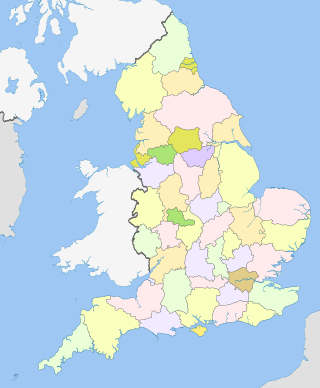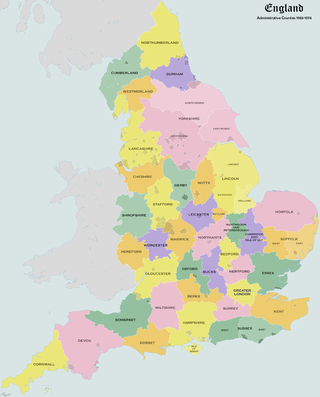Related Research Articles

Metropolitan counties are a subdivision of England which were originally used for local government. There are six metropolitan counties: Greater Manchester, Merseyside, South Yorkshire, Tyne and Wear, West Midlands and West Yorkshire.

The North Riding of Yorkshire was a subdivision of Yorkshire, England, alongside York, the East Riding and West Riding. The riding's highest point was at Mickle Fell at 2,585 ft (788 m).

The counties of England are divisions of England. There are currently 48 ceremonial counties, which have their origin in the historic counties of England established in the Middle Ages. The current ceremonial counties are the result of the Lieutenancies Act 1997 and are based on the Local Government Act 1972 administrative counties which included a number of new counties such as Greater Manchester and Tyne and Wear. However, some counties introduced by the Local Government Act 1972, including Avon, Cleveland and Humberside no longer exist. The term "county", relating to any of its meanings, is used as the geographical basis for a number of institutions such as police and fire services, sports clubs and other non-government organisations.

Huntingdon and Peterborough was a short-lived administrative and geographical county in East Anglia in the United Kingdom. It existed from 1965 to 1974, when it became part of Cambridgeshire.

The Association of British Counties (ABC) is a non-party-political society formed in 1989 by television personality Russell Grant to promote the historic counties of the United Kingdom. It argues that the historic counties are an important part of Britain's cultural heritage and as such should be preserved and promoted. It also proposes that there be a clear official distinction between the historic counties and the administrative units known as counties—first described as a separate entity in the Local Government Act 1888.

Cambridgeshire and Isle of Ely was, from 1965 to 1974, an administrative and geographical county in East Anglia in the United Kingdom. In 1974 it became part of an enlarged Cambridgeshire.

The Redcliffe-Maud Report was published in 1969 by the Royal Commission on Local Government in England, under the chairmanship of Lord Redcliffe-Maud. Although the commission's proposals were broadly accepted by the Labour government, they were set aside by the Conservative government elected in 1970.

The Local Government Act 1972 is an act of the Parliament of the United Kingdom that reformed local government in England and Wales on 1 April 1974. It was one of the most significant Acts of Parliament to be passed by the Heath Government of 1970–74.
The history of the English county of Rutland, located in the East Midlands. It was reconstituted as a district of Leicestershire in 1974 by the Local Government Act 1972. This district was given unitary authority status on 1 April 1997.

Metropolitan and non-metropolitan counties are one of the four levels of subdivisions of England used for the purposes of local government outside Greater London and the Isles of Scilly. As originally constituted, the metropolitan and non-metropolitan counties each consisted of multiple districts, had a county council and were also the counties for the purposes of Lieutenancies. Later changes in legislation during the 1980s and 1990s have resulted in counties with no county council and 'unitary authority' counties with no districts. Counties for the purposes of Lieutenancies are now defined separately, based on the metropolitan and non-metropolitan counties.

The Local Government Act 1929 was an act of the Parliament of the United Kingdom that made changes to the Poor Law and local government in England and Wales.

The Local Government Act 1958 was an Act of the Parliament of the United Kingdom affecting local government in England and Wales outside London. Among its provisions it included the establishment of Local Government Commissions to review the areas and functions of local authorities, and introduced new procedures for carrying these into action.
The Local Government Commission for Wales was established by the Local Government Act 1958 to review the organisation of local government in Wales and to make recommendations for its reform. It delivered its report in 1963 and was dissolved in 1967. Its recommendations were not carried out.
The Local Government Boundary Commission was established in 1945 to review the boundaries of local authority areas in England and Wales outside the counties of London and Middlesex. The commission produced its report in 1948 which proposed large changes to county-level areas of local government and changes in the structure and division of powers between tiers of administration. The commission's proposals were not acted on, and it was disbanded in 1949.

The Local Government Commission for England was the body responsible for reviewing the structure of local government in England from 1992 to 2002. It was established under the Local Government Act 1992, replacing the Local Government Boundary Commission for England. The Commission could be ordered by the Secretary of State to undertake "structural reviews" in specified areas and recommend the creation of unitary authorities in the two-tier shire counties of England. The Commission, chaired by John Banham, conducted a review of all the non-metropolitan counties of England from 1993 to 1994, making various recommendations on their future.
The history of local government in England is one of gradual change and evolution since the Middle Ages. England has never possessed a formal written constitution, with the result that modern administration is based on precedent, and is derived from administrative powers granted to older systems, such as that of the shires.

The Police Act 1964 (c.48) was an act of the Parliament of the United Kingdom that updated the legislation governing police forces in England and Wales, constituted new police authorities, gave the Home Secretary new powers to supervise local constabularies, and allowed for the amalgamation of existing forces into more efficient units.

The Local Government (Boundaries) Act 1887 was an Act of the Parliament of the United Kingdom. The Act established boundary commissioners to reform the areas of administrative bodies in England and Wales in preparation for the creation of elected councils by the Local Government Act 1888. In the event, the recommendations of the commissioners were not carried out.

Administrative counties were subnational divisions of England used for local government from 1889 to 1974. They were created by the Local Government Act 1888, which established an elected county council for each area. Some geographically large historic counties were divided into several administrative counties, each with its own county council. The administrative counties operated until 1974, when they were replaced by a system of metropolitan and non-metropolitan counties under the Local Government Act 1972.

The County Borough of Teesside was a short lived county borough and civil parish in the North Riding of Yorkshire geographical county, around the Teesside agglomeration. It was a 1968 merger of 7 council areas into a single district in. It was the third union of its type and the last to take place until the 1974 reform which replaced it with the wider county of Cleveland.
References
- ↑ London Gazette, issue no.41540, 4 November 1958
- ↑ London Gazette, issue no.41611, 20 January 1959
- ↑ London Gazette, issue no.41771, 21 July 1959
- ↑ London Gazette, issue no.42620, 13 March 1962
- ↑ London Gazette, issue no.43702, 2 July 1965
- ↑ London Gazette. 22 June 1965
- ↑ London Gazette, 2 March 1965
- ↑ "Radical Review of Local Government". The Times. 11 February 1966.
- ↑ "Halt to local reorganization". The Times. 4 May 1967.
- 1 2 3 4 5 "How Local government Areas Stand Today", The Times, 12 February 1966
- ↑ "Mergers of Midland Counties Proposed". The Times. 2 March 1960.
- ↑ Local government Commission for England: Report. number 2. West Midlands general review area at BOPCRIS website "Local government Commission for England: Report. Number 2. West Midlands general review area". Archived from the original on 27 September 2006. Retrieved 14 August 2006.
- ↑ "Outcry Grows Over Midland Counties", The Times, 8 March 1960.
- ↑ "New amalgamations proposed for small counties". The Times. 2 August 1961.
- ↑ Local Government Commission for England: report and proposals for the East Midlands general review area (report number 3) at BOPCRIS website "Local Government Commission for England: Report and proposals for the East Midlands general review area (Report number 3)". Archived from the original on 27 September 2006. Retrieved 14 August 2006.
- ↑ "Report of the inquiry into objections to the proposal to amalgamate Leicestershire and Rutland, and to the recommendations that the present county of Rutland (subject to minor boundary adjustment) should form a single rural district'" at BOPCRIS website "Local Government Commission for England: Report and proposals for the East Midlands general review area (Report number 3)". Archived from the original on 27 September 2006. Retrieved 14 August 2006.
- ↑ "New Amalgamations Proposed For Small Counties", The Times, 6 August 1961.
- ↑ Local Government Commission for England: report and proposals for the South Western general review area (report number 4) at BOPCRIS website "Local Government Commission for England: Report and proposals for the South Western general review area (Report number 4)". Archived from the original on 27 September 2006. Retrieved 14 August 2006.
- ↑ "Somerset Unlikely to Lose Towns". The Times. 5 July 1961
- ↑ Letter to the Editor, by Ralph Oliver, Mayor of Lyme Regis, 27 December 1961
- ↑ "County borough status advised for Cheltenham and Torbay". The Times. 3 February 1963
- ↑ Local Government Commission for England: report and proposals for the Tyneside special review area (report number 5) at BOPCRIS website "Local Government Commission for England: Report and proposals for the Tyneside special review area (Report number 5)". Archived from the original on 27 September 2006. Retrieved 14 August 2006.
- ↑ "Tyneside Hearing Opens". The Times. 25 July 1962.
- ↑ "Tyne Plan "Already Obsolete". The Times. 17 July 1963
- ↑ "Tyneside Boundary Decision Soon". The Times. 12 October 1965.
- ↑ "More Groups of Towns". The Times. 15 December 1965.
- ↑ "Minister wants all-purpose borough for Tyneside". The Times. 15 December 1965
- ↑ London Gazette, 8 March 1966
- ↑ Local Government Commission for England: report and proposals for the North Eastern general review area (report number 6) at BOPCRIS website "Local Government Commission for England: Report and proposals for the North Eastern general review area (Report number 6)". Archived from the original on 27 September 2006. Retrieved 14 August 2006.
- ↑ Local Government Commission for England: report and proposals for the West Yorkshire special review area (report number 7) at BOPCRIS website "Local Government Commission for England: Report and proposals for the West Yorkshire special review area (Report number 7)". Archived from the original on 27 September 2006. Retrieved 14 August 2006.
- ↑ "Heavy Woollen Area Plan", The Times, 19 July 1962
- ↑ "Wakefield angered by plan to lower status" The Times, 12 March 1964
- ↑ London Gazette. 26 June 1964
- ↑ "Boundary extensions proposed for seven county boroughs". The Times. 25 June 1964.
- ↑ "Wider Frontiers Planned for Seven Towns". The Times. 6 September 1962.
- ↑ "Boundary Changes Proposed in East Anglia". The Times. 13 May 1963.
- ↑ "Bigger Towns Emerge in Plans for East Anglia". The Times. 6 May 1965.
- ↑ "Struggle for Survival in South-East Lancashire". The Times. 18 July 1960.
- ↑ "New County Proposed for North West". The Times. 15 December 1965.
- ↑ "Dorset fights to keep Poole", The Times, 27 July 1965
- ↑ "County borough status for Slough opposed" The Times, 23 July 1965
- ↑ "Merger of three counties sought", The Times, 27 October 1965
- ↑ "Aldershot's ambitions opposed by Surrey". The Times. 15 July 1965.
- ↑ Bryne, T., Local Government in Britain, (1994)